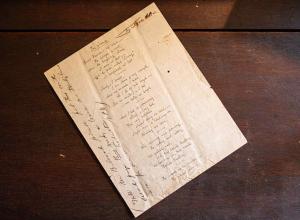A History of Western Script at Christie’s London in November
London—On 20 November 2013 the Christie’s London sale of Valuable Manuscripts and Printed Books will be led by a previously unrecorded Book of Hours, illuminated throughout by the Master of Claude de France (estimate: £500,000 - 800,000). The selection of printed books dating from the 15th to 20th century is highlighted by a first edition of the most important scientific work of the 16th century, Nicolaus Copernicus’ De revolutionibus orbium coelestium, libri VI (estimate: £400,000 - 600,000). The sale will also feature a single-owner collection representative of centuries of medieval manuscript production, with vellum leaves ranging from the earliest specimen of Beneventan script currently in private hands—also the oldest manuscript Old Testament ever recorded in Beneventan minuscule (estimate: £35,000 - 50,000, illustrated left)—to the missing pages from the only copy of the most important biography of Thomas Becket by Herbert of Bosham (estimate: £30,000 - 50,000).

The collection also features: religious fragments in Carolingian, Visigothic and Anglo-Saxon script; a leaf from a 14th-century pattern book; intact books including a magnificent 12th-century glossed Genesis in its original binding (estimate: £200,000 - 300,000); a striking English 13th-century Bible illuminated by the Sarum Master (estimate: £100,000 - 150,000) and a charming Book of Hours by the Talbot Master (estimate: £45,000 - 70,000).
ILLUMINATED MANUSCRIPTS
Leading the sale is a previously unrecorded Book of Hours, illuminated throughout by the Master of Claude de France (estimate: £500,000 - 800,000, illustrated right). This artist, named after two manuscripts he painted for the queen of France, wife of François I, was active in the early decades of the 16th century. He worked with an unsurpassed subtlety and delicacy of handling and colour and his miniatures combine a sophisticated naturalism with beguiling charm and immediate appeal. This jewel of a manuscript comes from the property of a Scottish nobleman and has royal provenance; it is believed to have been created for Claude’s sister Renée and was later in the collection of Princess Charlotte Augusta of Wales.
Further highlights include a rare English folding almanac (estimate: £100,000 - 150,000, illustrated left). This previously unrecorded example dates to the 15th century and is still in its original binding. It is one of only thirty of its kind to survive. A portable compendium of calendrical, computational, medical and astrological material, the folding almanac would most likely have been worn by a physician. Folding almanacs - or girdle books - were worn at the waist and were brought out when consulting patients. Featuring tables of solar and lunar eclipses and a Zodiac Man, this almanac provides a fascinating insight into the fundamental importance of astrology in medieval medicine.
The eclectic nature of the sale is exemplified by a splendid 16th-century Genealogy of the kings of England from William the Conqueror to Elizabeth I prepared by Morgan Coleman for Francis Bacon, Viscount St Alban (estimate: £50,000 - 80,000). Published in Baconiana in 1949, it was argued that the manuscript supported the theory of Bacon’s royal birth and his rightful role as successor to Elizabeth.
PRINTED BOOKS
Leading the selection of printed books is a first edition of the most important scientific publication of the 16th century, Nicolaus Copernicus’ De revolutionibus orbium coelestium, libri VI (estimate: £400,000 - 600,000, illustrated right). De revolutionibus placed for the first time the sun at the centre of the universe and described the earth's diurnal rotation and its annual rotation around the sun. Copernicus denounced the geocentric belief in the immobility of the earth as based on mere appearance. In order to entertain an idea such as a heliocentric universe Copernicus had to break with virtually all current knowledge: astronomical, metaphysical, theological and, most basically, simple sensory perception. The geocentric system of Ptolemy had held sway for over a millennium, and theological dogma considered geocentrism as the very foundation of the special relationship between God and man. Aware of the radical nature of his theory, Copernicus composed an introduction in which he attempted to trace historical antecedents for his basic tenets. He cites antecedents for the mobility of the earth in Pythagoras and Heraclides and for the earth's revolution around the sun in Aristarchus. While these antecedents provided a handy defence for Copernicus, it is unlikely that they played any signifcant role in developing his theory (cf. Gingerich, Eye of Heaven, 1993). The Church in fact never officially condemned Copernicus's work as heretical, in part because its observations were essential to reform of the calendar and thus to the precise determination of Easter.
Another first edition of an important scientific publication to be offered is René Descartes’ Discours de la methode pour bien conduire sa raison, & chercher la verité dans les sciences. Plus La Dioptrique. Les meteores. Et la geometrie. Qui sont des essais de cete Methode (estimate: £30,000 - 40,000, illustrated left). This work is considered to be the foundation of all modern scientific and philosophic thought. Descartes was thought to be the first modern philosopher and one of the first modern scientists. Discours includes Descartes’ famous dictum, cogito, ergo sum, (I think, therefore I am) and the first discussion by a foreign scholar of Harvey's discovery of the circulation of blood.
PRESS CONTACT: Dernagh O’Leary | +44(0)207 389 2398 | doleary@christies.com
Please click here for the complete eCatalogue.
PUBLIC EXHIBITION:
Saturday, 16 November 2013: 12:00pm - 5:00pm
Sunday, 17 November 2013: 12:00pm - 5:00pm
Monday, 18 November 2013: 9:00am - 4:30pm
Tuesday, 19 November 2013: 9:00am - 8:00pm
AUCTION:
Valuable Manuscripts and Printed Books
20 November 2013
10:30am















